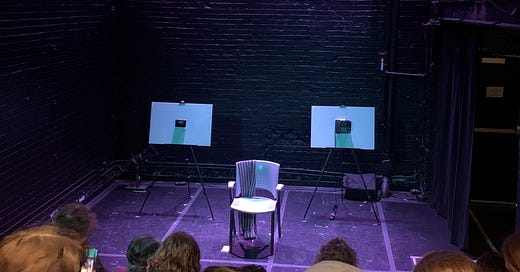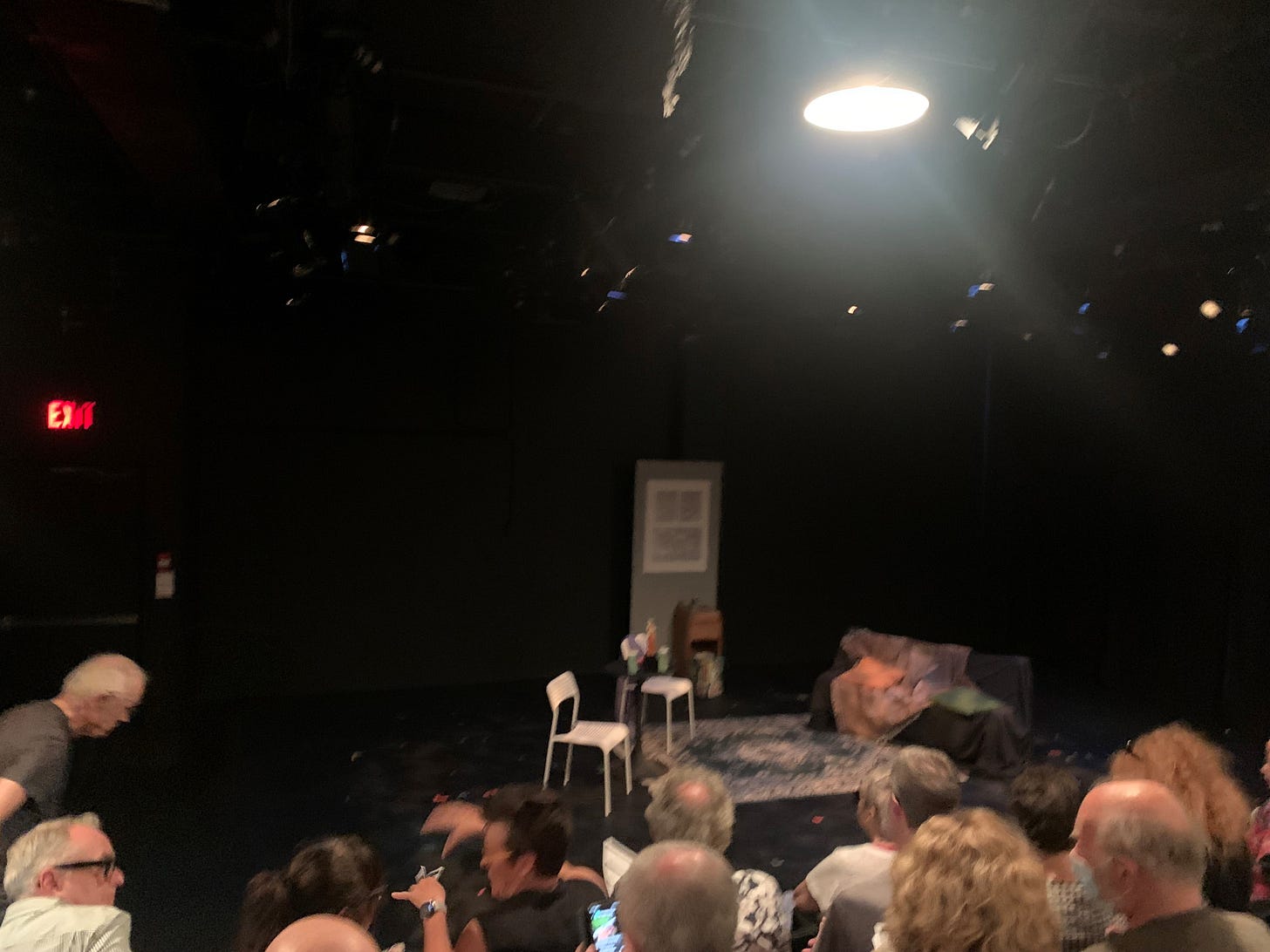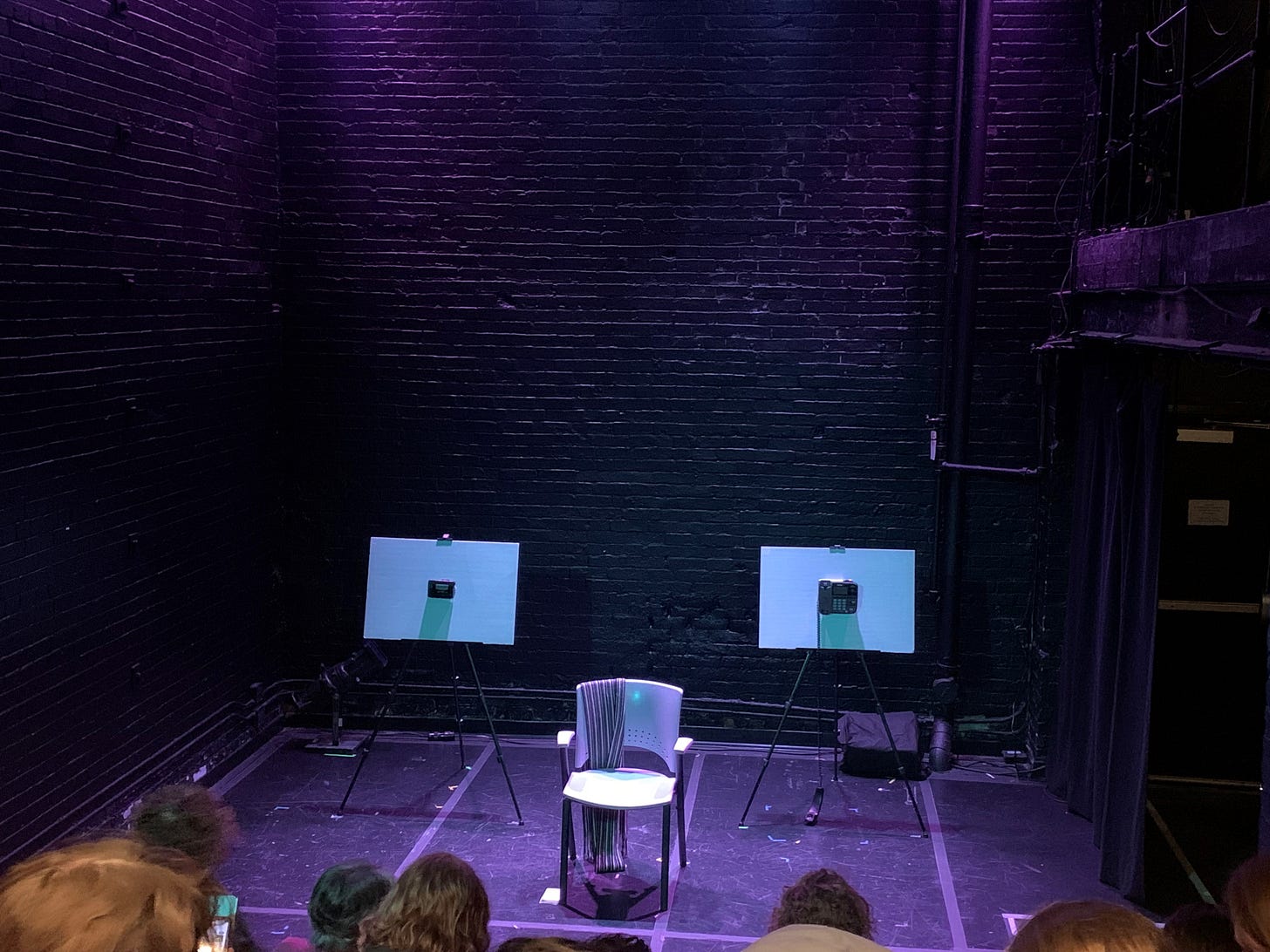[Thank you for reading David’s Folly, a place where I expand my coverage of the art and entertainment industry beyond my regular work in video games into movies, TV, books, theatre, and music. This post is free, so please feel free to share it with a friend, and if you like you can help support my work further by subscribing.]
The Toronto Fringe Festival is back for another year, and I’m back at attending Fringe. As a theatre kid the few early memories I have of Fringe are ones that I cherish, because I think it’s just the coolest thing to see a few or a bunch of shows, each of them a mix of new and veteran artists all trying something. Whether or not that thing is ‘new’ or even ‘good’ almost feels irrelevant, because picking a show to see that ends up being shit is also inherently part of the Fringe Fest experience.
I’m not saying anything I saw this year was shit, just that the variety of Fringe Festivals is what makes them fun, and their ultimate goal of promoting and platforming new artists and being grounds for experimentation is vital for any good arts scene. Thank you for coming to my TED talk/love letter about why Fringe is cool and I like it. You should go to your local Fringe Festival every year, if you can.
This year I knew I wanted to ‘return’ to Fringe, because it had been two years since I was last able to go. My original plan was to buy one of the festival passes and do six shows total, and write about each of them. That would be a lot, yes, but I also liked how that sounded and thought it would be a good chance to see a variety of shows.
My dog getting spayed the same weekend this year’s festival kicked-off changed those plans, because it would be a lot to try and see six shows on top of keeping a closer eye on Tilly and regular work and everything else. My wife spoke sense, and, like any smart husband, I understood and agreed.
So it was resolved that I would see three shows, and in doing so spend a little more time with each one than I could’ve reasonably done with six. Perhaps one year I’ll do every show in that year’s festival, and write one line succinct about each. Give myself a writing and scheduling challenge - but that’s a dream for another day.
I narrowed the six I had originally chosen down to three, and ended up being able to see The Apartment from Nevah Productions, Cabaret of Murder from Blair Moro and Gulp, from Lady Luck.
Full disclosure, I chose Gulp because the artists involved are all people I met at university, all in the same theatre program I was in, but in different years. I even worked on a few campus shows with some of them, so when I saw their show listed I felt I had to see it.
My connections to the cast and crew won’t be impacting my review of the play, it’s just something I need to make you aware of.
The Apartment from Nevah Productions
Written by Paul Bilodeau, Directed by Nicole Arends
Similarly to how I felt about picking Gulp, I felt I had to see The Apartment because it’s set in my own neighbourhood. Set in sunny Parkdale in Toronto, Bonnie played by Cathy Shilton is trying to hold on to the best apartment she’s ever had. She’s been living with psychosis and mental illness her whole adult life, and as the playwright himself describes has “faced a life of poverty and precarious housing, but with patience, good humour and courage.”
I’ll say first that Parkdale is an amazing area, I’m definitely bias about that because I live here but that doesn’t change the fact that it’s true. There are wonderful local shops, it’s a joy to walk around, and there’s a real community you’d struggle to find elsewhere in Toronto. It also has a history of being trafficked by drug addicts and quote-unquote “crazy people.” Bonnie’s sister, Amy, played by Elizabeth Friesen even has a line where she says “Parkdale is full of crazy people and druggies,” and she’s not entirely wrong. Of course there’s much more to the area than that but the truth is there are people in the area who live like Bonnie in the play. People who’ve struggled with mental illness their whole lives and now rely on government disability cheques to keep going.
“Poverty is so hard, sister,” Bonnie says to a nun that only she can see. This line is an early moment in the play, and Shilton’s excellent delivery made it land with a thud you could feel. It was a moment that to me really indicated Shilton’s talent. The whole 60 minutes she was a strong lead who kept the play grounded and on track, even with jumpy scene partners. Paul Bilodeau, playwright and actor for the role of Tobey was the worst for this to me. Perhaps he was just leaning too far one way with the character, but I found his hap-hazard movements at times to be too much, it even seemed to make him rush through his lines, something you definitely wouldn’t expect from the playwright.
Especially because it was a very well written play. The performances overall were good but that works on a curve with Shilton and Friesen doing the bulk of the heavy lifting. Bilodeau’s words are what allowed everyone else to shine. There was just this genuine sense to them that helped pull you in closer to these characters. Which makes sense, considering that a quick read of the back of the program tells you Bilodeau based the character Bonnie off his sister. At the top of the review when I cited that he described Bonnie as facing poverty with “patience, good humour and courage,” the full context is that he’s describing how Bonnie and his sister are alike.
Not much else about The Apartment stood out. The lighting was simple, did its job but was never utilized in any meaningful way. Sound design felt similar, though I did think it sounded like Parkdale so perhaps I’m not giving it the credit it deserves.
What really made The Apartment sing was its writing and the amazing performances from Shilton and Friesen who carried it all. I would also be remiss if I didn’t mention Jan Boase who played the nun that Bonnie saw, who is also listed as “The Shadow” in the program. Her piercing looks towards Shilton said more than words could, and the moments that brought focus to her were effective, and I could’ve even done with a few more.
Cabaret of Murder
Written & Directed by Blair Moro
The second show I saw at this year’s Fringe was also the only one I had company with. My best friend of many years was able to join me, and I’m glad he did because this was the show I had the most to talk about after seeing it.
Cabaret of Murder presents a cabaret of different works that have each been created by killers. The cast, consisting of Katie-Rose Connors, Paulina Pino Rubio and Bella Ciccone each play various roles across 60 minutes singing songs, reciting poetry, staging screenplays and monologues all written by killers, taking a pause in between each work to tell you which killer wrote what you just saw and how many people they killed.
It’s a tonal shift that gets repeated again and again the whole show, and one that truthfully waned on me by the end. I want to be clear, I’m not faulting the performers - each of them were a lot of fun to watch and all very entertaining. They made the whole audience laugh and gave us all an enjoyable time. That’s another thing I want to be clear on, I had a good time in that 60 minutes. It’s all the time I’ve spent since thinking about this show that continually sours it for me. I’m sure if Moro were to ever read this, they’d probably say “Well stop thinking about it then.” Sorry, not an option.
It’s not an option because for the life of me I can’t figure out what the point of it was. What’s the point of doing all this? Why am I hearing a song written by a cult leader who is responsible for the deaths of 76+ people? This particular song was one that the cast got the audience to sing and clap along to, and we hesitantly did since I’m sure I wasn’t the only one thinking “I don’t know if I want to sing a song some killer wrote.” However the social awkwardness that might arise if they kept egging us on to sing and no one did or the polite senses of a Fringe audience (or both) got us all singing and clapping on beat before we were told about David Koresh and the Waco Siege.
The conceit of the show is presented as being a mixture of works all created by killers, showing that even killers can and have tried their hand at art. That point gets nailed down into the audiences head again and again, every time we laugh along at the camp-y and hammed-up performances only for those to be sharply cut with reality. Then just as quickly as they went away, the smiles return and we’re on to the next thing.
Cabaret of Murder tries to convince its audience that it is taking these solemn moments respectfully and is aware that these works all came from real people who killed and harmed the lives of hundreds of other real people. But I never felt that. I felt shallow by the time I got home that night, wondering why Moro needed to use art from real killers to create this macabre comedy.
There was never anything more the show had to say about the connection between these killers and art. Just that they did it, while saying to the audience “Look, this person who also killed people wrote a really bad play. See how bad it is, isn’t that funny?” And sure, maybe it’s so bad it’s a little bit funny, but not funny enough that it carries a whole 60 minutes without having anything more to say. Mocking these killers by looking down on their works only goes so far. They deserve to be mocked, sure, but do they deserve to be staged like this? To be brought up and performed to an audience of paying customers? Before the show was barely halfway through I was waiting for a second & third lever that never got pulled, and instead lever 1 was pulled up and down repeatedly.
To come back around, if I’m faulting anyone I’m faulting Moro. With no plot or overarching story line to carry through to some kind of point, and nothing more to say than what you can read in the show’s description on the Toronto Fringe website, I can’t think of a reason anyone needs to see this show, or why it needs to exist.
And again, I was definitely entertained that evening at Alumnae Theatre. But that credit for why that was goes entirely to Connors, Rubio and Ciccone.
I know that not all art has to have a point, per say, or a moral of some kind or lesson-like takeaway. I’m not asking that from Cabaret of Murder. I also understand it to be an attempt at satire, but that’s a thin veil which offers no protection in my eyes. I’m asking for it to have a reason to go up on a stage. You might not think a play needs a reason to be staged, and that’s fine, we’ll just disagree on that. I also know I’m definitely in the minority in my thinking on Cabaret of Murder. It’s an award-winning show that has toured a few Fringe Festivals at this point. Lots of other people like it, and that’s great for them.
I just think there’s a deeper, better version of this show that actually tries to grapple with something - anything - and works really well to subvert the fixation so many of us have on true crime and the media landscape that has grown out of it. Instead, Cabaret of Murder says nothing, does nothing, and I’m left thinking of all the better ways I could’ve spent my time, watching a play that actually has a reason for being staged.
Gulp
Written & Performed by Frosina Pejcinovska, Directed by William Dao
The last show I saw at Toronto’s 2024 Fringe Festival was also far and away my favourite. Now I feel obligated to remind you if you forgot that this is the show created by people I met back in my theatre school days. I was friendly with key members of the crew for a few years before we all went our separate post-graduate ways and the pandemic siloed us even further away. Those relationships are not why I liked Gulp the most, or why I think it was the best play I saw out of the three.
It just was the best play. Pejcinovska was captivating as the sole onstage performer as she, as the protagonist Sunday, unraveled what happened to Sunday’s best friend. Dao’s directing helped pace the narrative out with subtle beats, and the simplistic but effective set design from Brad Gira worked to allow the chilling sound design by Matt Lalonde to be even more impactful. I also need to shout out the lighting design by Matthew Ivanoff. I think a strong lighting design is at its best when you’re not noticing it until a key moment in the play arises and then you notice how strong it is, and intentionally or not Ivanoff accomplished that here.
Gulp, first and foremost is about listening, and what the responsibility of the person listening is. It’s the central theme of the play and the thing that drives Sunday’s relationships with the two other people she talks about most in the show. Her best friend, and Dr. Champion, a therapist who it very clearly seems is using Sunday for his own personal reasons under the guise of helping her pro-bono. I couldn’t help but get more and more creep-d out every time Sunday describe another encounter with Dr. Champion. While Sunday made it clear she was interested in his advances, it also felt clear that Dr. Champion was using her, which only added to the tension I felt.
But what’s also interesting about that is we’re led to believe both these primary side characters are using Sunday. She’d talk about the times she felt taken advantage of or used by her best friend, and then a minute later describe a situation where she seems to be conscious of how Dr. Champion is using her, but in his case she doesn’t seem to mind because of her romantic interest in him.
Then there are multiple voice messages from Sunday’s best friend that play and most of the time interrupt Sunday while she’s trying to explain her side of the story. These messages give us insight into how Sunday’s best friend was definitely manipulative, that much appears true, but they also cast doubt on Sunday’s entire version of events. As Sunday explores what her responsibility as a listener is, the audience is implicitly asked to determine their own role as listener. Do we accept Sunday’s version without question? Is that our role here? Or is it just to let Sunday have her piece said, understanding her to be an unreliable source, while accepting that she needs to tell the story her way.
Unlike other unnamed shows I saw this Fringe Festival, Gulp actually had something to say and challenged you to think not just about the play but about your own life and what your role as a listener is to the people around you. It was incredibly effective in its execution of this story, and I can’t help but feel a sense of pride to say that I walked the same rehearsal spaces these artists did, and that I got to work with some of them, even if it was only in a small way.
Should Gulp ever return to a Fringe Festival near you, or if it is able to have a run at a local theatre, you absolutely must not miss it.
[Thank you for reading David’s Folly, a place where I expand my coverage of the art and entertainment industry beyond my regular work in video games into movies, TV, books, theatre, and music. This post is free, so please feel free to share it with a friend, and if you like you can help support my work further by subscribing.]







